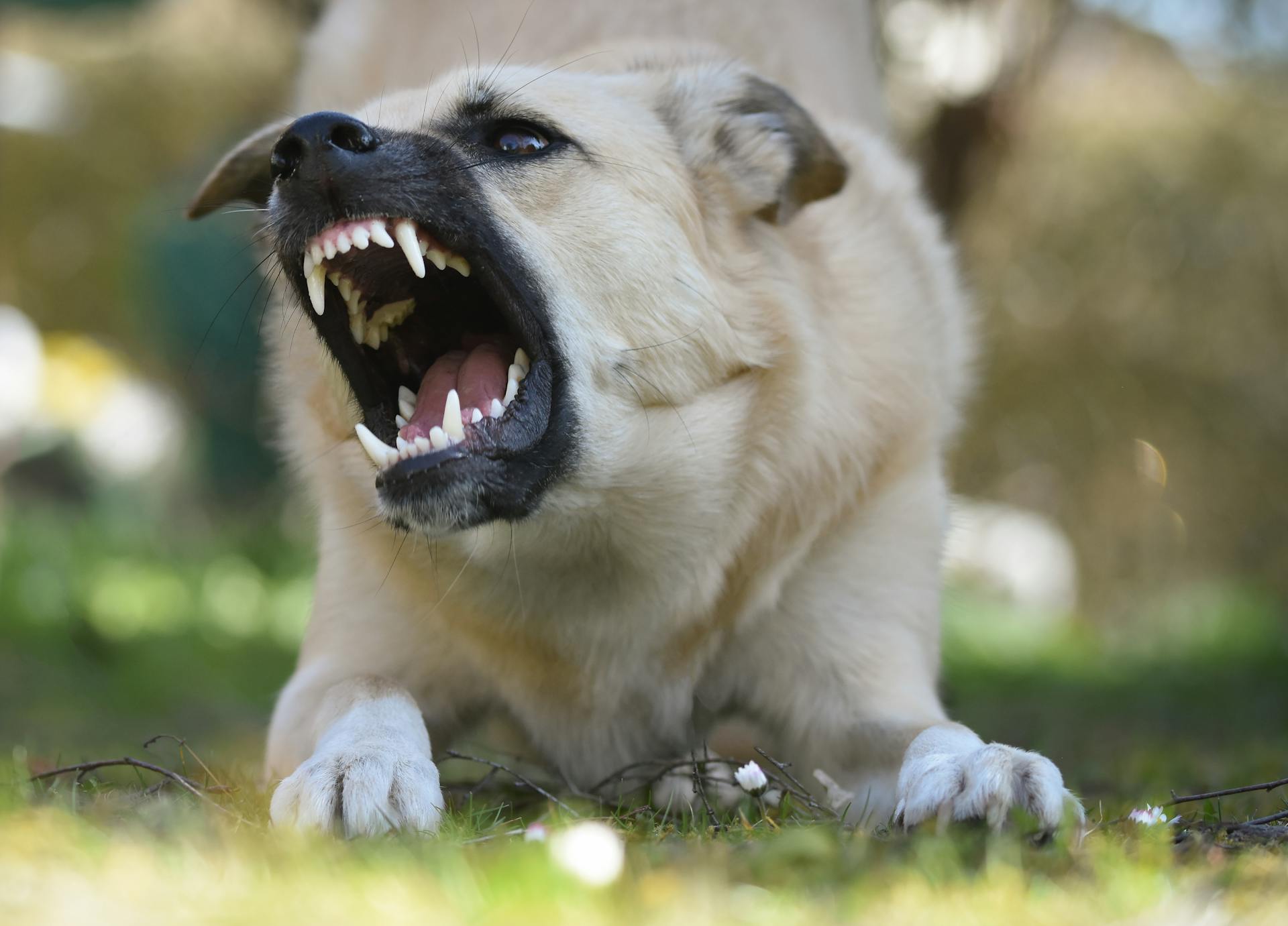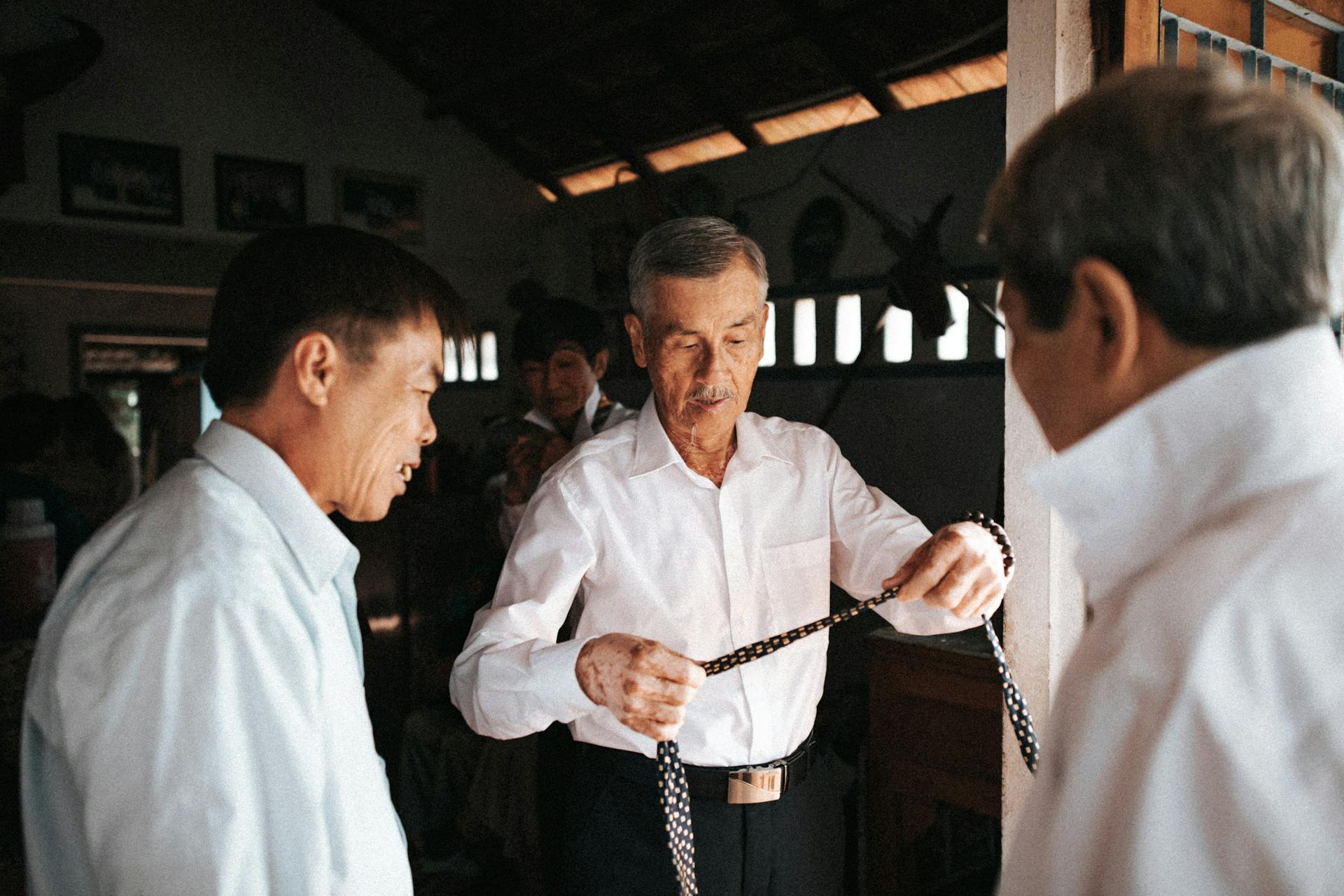
Grooming a difficult dog requires patience and understanding of their behavior. This approach can help reduce stress for both you and your dog.
One key strategy is to introduce grooming gradually, starting with short sessions and gentle touch. This allows your dog to become comfortable with the process.
A difficult dog may exhibit fear or aggression due to past negative experiences or lack of socialization. Understanding the root cause of their behavior is crucial to developing an effective grooming plan.
By moving at your dog's pace and being mindful of body language, you can create a more positive experience.
Here's an interesting read: Dog Boarding for Difficult Dogs
Understanding Difficult Dogs
Some dogs show aggressive behavior that can become a problem for their owners and families, even when it's time for grooming.
Aggression can involve a wide range of behaviors that can lead to attacks and injuries, including dog bites during grooming.
Signs of aggression in dogs include threatening growls or barks, remaining still and not obeying instructions, growling when wishes aren't followed, and snarling or mouthing a person against their wishes.
Here are some common signs of aggression in dogs:
- Threatening growl or bark
- Remaining still and not obeying an owner's or carer's instructions
- Growling when the dog's wishes aren't followed
- Snarling (baring teeth when growling)
- Mouthing a person against his or her wishes in an effort to exert control
- A quick bite that leaves a mark, bruise or puncture in or on the skin
- A quick succession of bites
- Biting followed by shaking
An aggressive dog may bite or show other aggressive behaviors during grooming sessions for numerous reasons, including feeling anxious, fearful, confused, or having had previous bad experiences while being groomed.
On a similar theme: Aggressive Behavior in Puppies Training
Preparation and Prevention
Some aggressive dogs may not calm down during grooming sessions, but they'll still need to be groomed. To make the process smoother, consider using unique anxiety-reducing jackets during nail trims, organic and all-natural medications, or muzzles. Speak to your vet about which option is best for your dog.
Before grooming, it's essential to ensure the environment is quiet, calm, and peaceful. This can help reduce your dog's stress levels and make the experience more enjoyable for both of you.
Asking your dog to perform an easy trick or action, such as 'sit' or 'shake paw', can also be helpful in calming them down. Offering treats can be a great motivator, but be sure to use them sparingly to avoid overfeeding.
Curious to learn more? Check out: How to Calm a Dog for Grooming
Taking frequent breaks is crucial when grooming a difficult dog. This allows your dog to relax and recharge, making the process less stressful for both of you.
Here are some additional steps you can take to make grooming easier:
- Playing soothing music can help calm your dog
- Opening a window can provide a calming breeze
- Asking your vet for advice on sedation or other options if your dog is extremely aggressive or fearful
Calming Techniques
Staying calm is crucial when grooming a difficult dog. If you're feeling anxious, your dog will pick up on it and become anxious too.
Consider walking your dog to the groomer if possible, as a walk is a great way to burn off nervous energy and help your dog arrive feeling calm and confident.
Having all the grooming tools ready before bringing your dog into the room will help you remain calm throughout the process. Being prepared is key to a successful grooming session.
Speak to your dog calmly and let them safely sniff and explore tools like brushes and clippers. This will help them become familiar with the equipment and reduce stress.
A different take: Dog Grooming for Anxious Dogs
Get your dog used to being rubbed with a towel and introduce them to scissors or trimmers without cutting their claws. This desensitization process will make the actual grooming process much smoother.
Here are some tips to keep your dog calm during the grooming process:
- Keep sessions short and make an effort to introduce groomers, grooming equipment, and new procedures gradually.
- Let your dog sniff the grooming area for a while before settling in, following up with praise and a reward.
- Once your dog is comfortable with the groomer and equipment, grooming will go much smoother for everyone.
Remember, building trust with your pup is essential when it's time to bathe and groom them. The less stress they're put under, the more calm and cooperative they will be.
Positive Reinforcement
Positive reinforcement is a powerful tool in training a difficult dog to stay calm and relaxed during grooming. Offering treats and praise when your dog sits still to be brushed or lets you clip a nail will teach your dog good grooming manners.
It's essential to take it slow, even if that means only clipping one nail at each attempt, to avoid overwhelming your dog. Positive reinforcement can be a game-changer in making grooming a more enjoyable experience for both you and your dog.
For your interest: Dog Nail Grooming
Introducing your dog to being groomed as a puppy will save a lot of anxiety and stress down the road. Puppies enjoy having new experiences and are open to being socialized and learning.
Giving a treat before visiting the groomers (or before an at-home grooming session) may help keep your dog calm. You can also give another treat for sitting patiently during their bath and grooming.
Using treats as rewards for calm behavior and cooperation is a great way to make grooming a positive experience. If your dog gets in the bath or shower, give them a treat, and continue with the positive reinforcement training techniques throughout the grooming session.
Intriguing read: How Much Is a Dog Grooming Session
Grooming and Hygiene
Grooming is an essential part of caring for your dog's health, especially for difficult dogs. Using wipes before bathing can help get rid of stubborn stains without having to try and wash and wipe too hard in the shower.
Wipes are a convenient option for quick refreshes or cleanups of sensitive areas. Pet-safe wet wipes are a must-have for any dog owner, and Hepper's Wash Wipes are a great choice due to their effectiveness on dirt and odors while being gentle on the skin.
It's crucial to use a dog-specific shampoo that won't cause irritation and skin dryness. Hepper's soothing oatmeal shampoo is a great option, free of soaps and harsh chemicals.
Drying your dog thoroughly after a bath is just as important as the bath itself. Leaving the coat wet can irritate your dog and make them more susceptible to yeast infections.
Here are some key tips to keep in mind when grooming your difficult dog:
- Use wipes to hit problem areas before bathing.
- Choose a dog-specific shampoo that's gentle on the skin.
- Dry your dog thoroughly after a bath to prevent irritation and infections.
Medication and Sedation
If your dog is extremely anxious or fearful during grooming, it may be necessary to visit your vet to discuss medical sedation options.
Your veterinarian may prescribe diazepam, acepromazine, gabapentin, or fluoxetine as sedatives for your dog.
Never give sedation medications to your dog without first consulting your veterinarian.
Before asking your vet for sedatives, consider whether your dog gets incredibly anxious, has always been this way, or if this is a new behavior.
You should also ask yourself if you've tried grooming your dog yourself and if different groomers have made a difference.
Sedatives should be used as a last resort when all other options have been exhausted, especially in cases where the dog is affected by severe anxiety that doesn't respond to behavior modification or when there are risks for defensive biting.
If you have already tried several options and find that your dog undeniably needs sedatives, then you will have to see your veterinarian or veterinary behaviorist for the most appropriate medication.
Here are some questions to ask yourself before opting for sedation:
- Does your dog get incredibly anxious?
- Has your pup always been this way, or is this a new behavior that needs to be addressed?
- Have you tried grooming your dog yourself?
- Did you try different groomers?
- Has your dog ever exhibited aggressive displays when being groomed?
Sources
- https://www.catawbaanimal.com/site/blog/2023/02/15/groom-senior-cat-copy
- https://www.dogster.com/dog-health-care/diy-dog-grooming
- https://www.wolfeanimal.com/site/blog/2022/05/30/dog-grooming-anxiety
- https://www.denvervet.com/site/blog/2022/11/30/aggressive-dog-grooming
- https://wagwalking.com/grooming/groom-an-aggressive-dog
Featured Images: pexels.com


